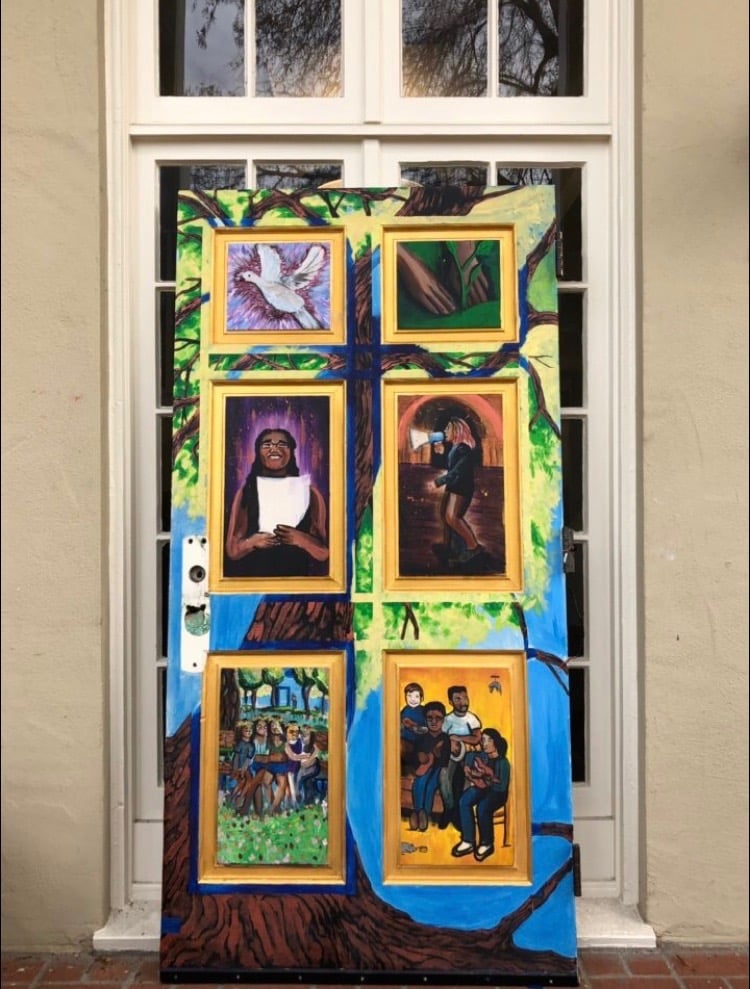Campus Planning has informed Columbae that it will paint over a front door mural it had confiscated from the co-op over the summer, Columbae leadership told The Daily.
The co-op’s front door was replaced over the summer due to a rule that prevents external painting on “historic” houses such as Columbae. The mural was returned to the house on Sunday and will remain until the end of the week so that the community can bid the painting farewell.
According to resident Ben Gaiarin ’19, members of the Columbae community met with representatives of Residential and Dining Enterprises (R&DE) and Residential Education (ResEd) before painting the mural last spring in preparation for the co-op’s annual spring concert, “F*ck the Man.” Gaiarin said R&DE and ResEd were willing to work with Columbae in the co-op’s plans to decorate but were concerned about how Campus Planning would respond.
These concerns prompted R&DE and ResEd to suggest options for the mural that were less permanent than painting directly on the wall should renovations become necessary, Gaiarin said. R&DE spokesperson Jocelyn Breeland told The Daily that they discussed options such as painting it on a canvas or another “contained” surface such as an interior door or a bathroom partition.
Gaiarin said that Columbae saw R&DE and ResEd’s suggestion of painting the mural on a door as the “go-ahead” and began painting their front door shortly after the meeting. The mural, which was created with the help of local artist Evelyn Anderson, featured a selection of images based on photographs of residents, along with an image of a dove and an image of two hands planting a seed. Residents say it represents Columbae’s tradition of creating art on the walls and symbolizes the co-op’s commitment to uplifting communities of color.
“It was this really beautiful coming together of the community around building this new image of the house,” Gaiarin said, referencing Columbae’s efforts in recent years to strengthen its commitment to racial inclusivity and social justice. “It was a collection of images that really represented, I think, what the house is about.”
However, when Columbae residents went back to meet with R&DE and ResEd after the mural was painted, R&DE and ResEd representatives expressed frustration with the lack of explicit communication, along with concern about how Campus Planning would respond.
Breeland wrote in an email to The Daily that attendees of the original meeting had discussed the Residence Agreement’s prohibition on painting interior or exterior areas of campus housing. They also discussed the fact that the Columbae house’s “historic” designation would necessitate input from Campus Planning, the group in charge of maintaining and preserving historically significant architecture on campus.
“Our understanding was that students would consider our suggestions and provide us a specific proposal for the mural to review,” Breeland wrote.
In hindsight, Gaiarin expressed regret that his co-op had not confirmed that this was a viable option with R&DE and ResEd.
“We were in kind of a jam for time, so with that half-baked permission, we decided to go ahead,” he said. “I think that there was a lack of responsibility on the part of the [Columbae] folks that were involved in the discussion because [the administration was] very much willing to work with us to make it happen.”
According to Breeland, R&DE then confirmed with Campus Planning that the mural would not be permitted.
“We have explored alternatives, such as turning the doors around so the mural was on the interior,” Breeland wrote. “This, we learned, is not possible.”
Over the summer, Campus Planning replaced Columbae’s front door with an unadorned white one and now plans to repaint the door with the mural on it. According to Gaiarin, it would cost the house $5000 to buy the painted door back and preserve the original mural. Instead, the house is in the process of recreating the mural on canvas, he said.
In a follow-up email to The Daily, Gaiarin wrote that while Columbae “certainly made some mistakes” and that ResEd and R&DE “do not deserve to be heavily criticized” for their handling of the situation, the controversy “does provoke some alarming questions” about the University’s priorities when it comes to housing.
“For one, how can the University expect to be an institution that encourages students to practice artistic expression if maintaining the campus’ ‘country club’ aesthetic is always prioritized?” he wrote. “Wouldn’t students need a space to practice such expression without needing to feel confined by the University’s haute standards? And if that space isn’t in their own residence, then where?”
In his email, Gaiarin also criticized Campus Planning’s prioritization of the Columbae house’s historical status over current residents’ efforts to make the house a more inclusive space than it has been in the past.
“The house’s history is largely tied to its occupants, a sorority and later a co-op that have both historically been white and wealthy,” Gaiarin wrote. “In recent years, Columbae has made an intentional choice to make their community a space that actively uplifts the voices of POC residents and students.”
“Is history about keeping a door white and made of a specific variety of wood?” he continued. “Or is history about recognizing that our narratives are constantly evolving and that we are empowered to shape those narratives to affect the way we live today?”
Contact Katie Keller at ktkeller ‘at’ stanford.edu.
